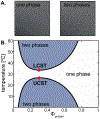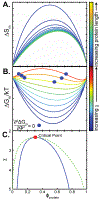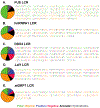Relationship of Sequence and Phase Separation in Protein Low-Complexity Regions
- PMID: 29517898
- PMCID: PMC6476794
- DOI: 10.1021/acs.biochem.8b00008
Relationship of Sequence and Phase Separation in Protein Low-Complexity Regions
Abstract
Liquid-liquid phase separation seems to play critical roles in the compartmentalization of cells through the formation of biomolecular condensates. Many proteins with low-complexity regions are found in these condensates, and they can undergo phase separation in vitro in response to changes in temperature, pH, and ion concentration. Low-complexity regions are thus likely important players in mediating compartmentalization in response to stress. However, how the phase behavior is encoded in their amino acid composition and patterning is only poorly understood. We discuss here that polymer physics provides a powerful framework for our understanding of the thermodynamics of mixing and demixing and for how the phase behavior is encoded in the primary sequence. We propose to classify low-complexity regions further into subcategories based on their sequence properties and phase behavior. Ongoing research promises to improve our ability to link the primary sequence of low-complexity regions to their phase behavior as well as the emerging miscibility and material properties of the resulting biomolecular condensates, providing mechanistic insight into this fundamental biological process across length scales.
Figures





References
-
- Brangwynne CP, Eckmann CR, Courson DS, Rybarska A, Hoege C, Gharakhani J, Julicher F, and Hyman AA (2009) Germline P granules are liquid droplets that localize by controlled dissolution/condensation, Science 324, 1729–1732. - PubMed
-
- Hyman AA, and Brangwynne CP (2011) Beyond stereospecificity: liquids and mesoscale organization of cytoplasm, Dev Cell 21, 14–16. - PubMed
Publication types
MeSH terms
Substances
Grants and funding
LinkOut - more resources
Full Text Sources
Other Literature Sources

